Fitting Flagship – part two
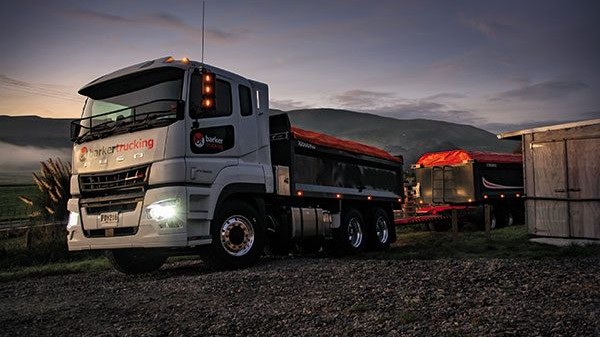
The words ring in our minds as we arrive in the Hawke’s Bay to meet Michael and the team at Barker Trucking to sample their 2651 Fuso Shoguns… “Suffice to say, the pigeons are about to be scattered” was how we introduced our sneak preview of the 12.8- litre Shogun in the August 2021 issue of New Zealand Trucking. We were excited to see what was in the making then, and we were just as happy to see the finished product just on a year later – the first chance we had. It would be an understatement to say that this model has been highly anticipated – a Japanese truck with the spec and powertrain to give the Europeans a real run for their money, with 50Max in mind.
Our last encounter with the Shogun was almost two and a half years ago when we headed south to enjoy the Te Anau-Milford Sound run with Clifford McDowell in the Northern Southland Shogun 3146; a memorable test if ever there were one. Back then, we speculated that a plus-500hp, 13-litre Shogun was already in the pipeline. This model needed to be right – hence more than 10,000km of local testing and fine-tuning in the skilled hands of Silverdale operator Skip Golden, specifically when it came to matching the transmission tuning to New Zealand’s demanding topography. Add to that 40,000km of testing in Australia, and you couldn’t accuse Fuso of not doing its homework to ensure it presented a truck that exceeded expectations.
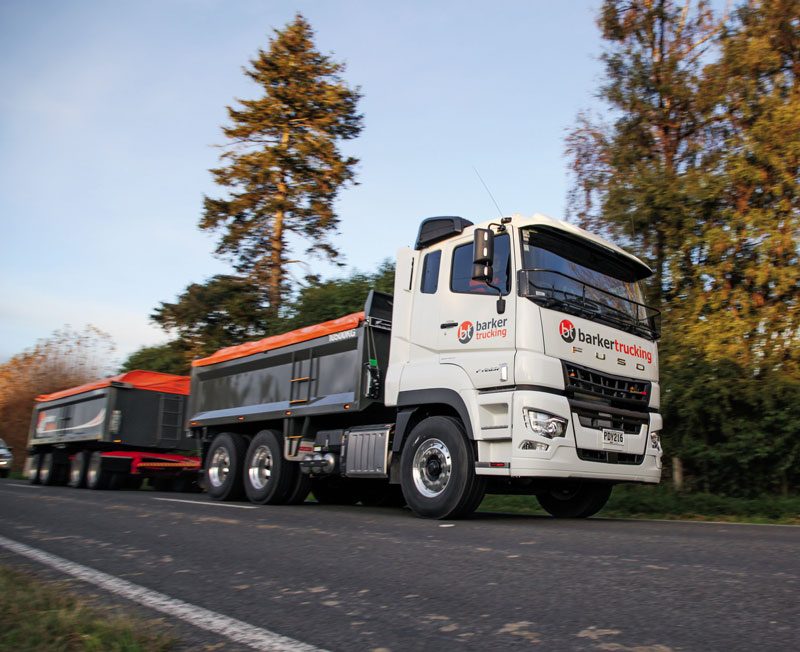
Hawke’s Bay to … anywhere
After owning an HD 470 and the current Shogun 2546, Michael was onto the 510 as soon as news of its development broke. “The HD was really good. I ordered a second one of those but ended up going for the new Shogun instead. One day, we were carting off to a country site, and I got dragged off by a Volvo… I thought, ‘Bugger this, we have to do something about this.’ I spoke to Chris [Holloway – truck sales Keith Andrews Trucks, Napier] and he said, ‘We have the new 510s coming. I’ll put your name down for one.’
“That’s Scotty’s one now, and being a solid businessman, I thought I’ll have another,” he says with a chuckle. Naturally, there’s more meat to the purchasing decision than that. “We’ve had a good run with Fuso. With the Shogun, I was impressed by all the safety features and the new generation Daimler powertrain,” he says. Perfect, that’s just what we’re here to experience.
Michael’s pulled in at the Waitangi Road Higgins yard at the end of the day to load up for the job ahead. Scott Tate in the second 510 isn’t far behind and arrives shortly after. Head on, the 510s immediately stand out with their unique, black, toothy grille as opposed to the honeycomb design and bold chrome bar we’ve become accustomed to with the rest of the range. The only chrome in sight is the ‘F-U-S-O’ script above the grille (the diamonds don’t even get a placement) and the familiar ‘Shogun’ badge, next to which is the defining red ‘510’ badge that jumps out at you should you miss the other giveaways.

The Barker trucks are simple and clean, with just the right amount of orange branding to tie in and set them off against the Kiwi Tarp roll back tarps. Hard wearing Hardox bins sit beneath the bright orange covers, proudly locally built by Chris Rooney’s Newports Transport Engineering business of Hastings. The fit and finish of the build shows that the Newports team definitely has an eye for detail.
“They have been absolutely brilliant to deal with, and obviously Chris’s connection to Gary Douglas Engineers shows in the design; purpose built for the job and built to last,” explains Michael.
The Higgins aggregate – a roading product made from recycled asphalt – is destined for a hilltop access road that leads to a cellphone-repeater tower on a farm about three-quarters of the way along the Masterton-Castlepoint Road. It’s a solid 500km roundtrip and, with 80-odd tonnes of the back stuff on order, it’s a job for all three trucks – so we’ll be able to benchmark the 510s’ performance against the 460. Most of it will be easy running down SH2 through the relatively flat Hawke’s Bay and Manawatu, and then a short jump over Mount Bruce to Masterton. The worst of it in terms of topography would be the 40km or so from there to our turn-off for the farm at Mangapakeha.
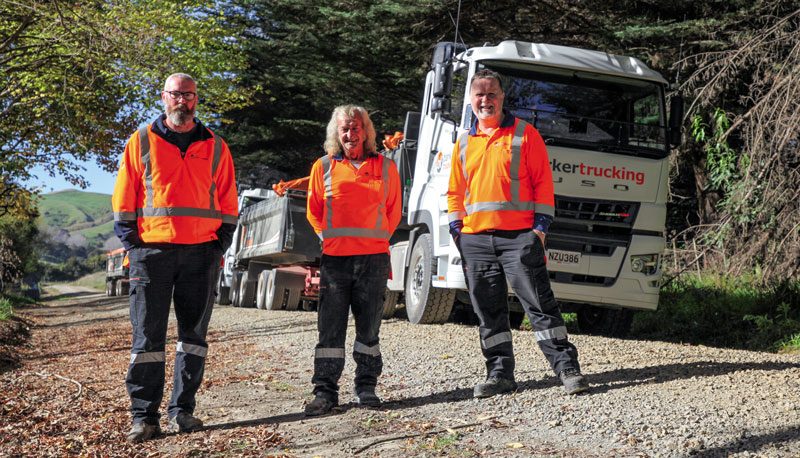
Pre-dawn the following morning, and we meet Michael at his place in the Te Aute Trust Valley. The first signs of daylight appear as we arrive, and Michael’s already giving his 510 the once-over before hitting the road. It doesn’t take long for the sun to break over the valley. “I think it’ll be a good day for it!” Michael quips. And how right he is … the weather gods are on our side with ideal conditions from start to finish. (The following day, the eastern half of the lower North Island was covered in a blanket of fog and misery. )
We head back towards SH2 and turn due south for our rendezvous with Scott and Ian Eriksen in the 460 at Waipukurau. With the three trucks together, we head just down the road to the Z Dannevirke truck stop for a quick splash and dash. From there, it’s into the cab with Scott. The immediate first question: ‘How does it compare with the 460?’ “They’re similar but totally different at the same time,” answers Scott. A lot to unpack, then.

Safe and snug
There’s not much to the trip between Hastings and Masterton. We’re running legal at about 45t gross, and the combination of the OM471 and third-generation Fuso Shiftpilot gets us up to a 90kph cruising speed smoothly and easily. “I drive it in auto economy all day; it never sees the power mode. It just gets on no problem at all,” says Scott as we discuss the various features of the 12-speed transmission.
Gear control is via the left-hand column stalk, and the driver can choose between eco, auto and heavy modes, with the ability to change gears by tapping the stalk back and forth. As it is in the 460, the transmission offers crawler and rock-free modes for when the going gets rough (“a huge benefit considering the places we go”, says Scott). And it makes use of eco roll and eco cruise technology to maximise efficiency on the open road.
“Eco roll is one thing that took me a little while to get used to,” Scott says, “but the adaptive cruise is great.”
As we enter Dannevirke, Scott demonstrates, following the car ahead through the town. The multi-information display on the instrument binnacle indicates the speed of the car in front and the following distance. “It’ll go right down to around 30kph and remain active. You can pretty much let someone else drive the truck for you. I’ll just leave it on if I’m following someone I know and trust.” The system will keep a lock on the vehicle ahead up to 200m.
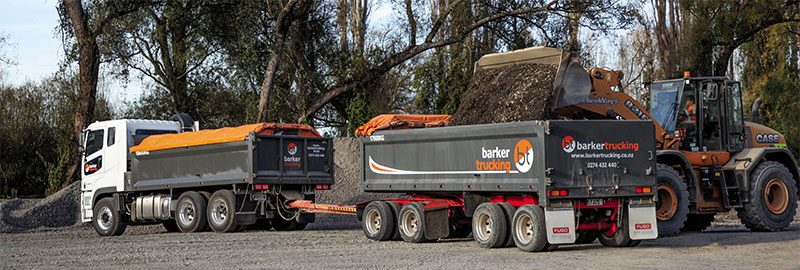
Since its introduction in 2019, Fuso has equipped the Shogun with high-level safety equipment, including adaptive cruise control (or proximity control assist in Fuso speak). For 2022, the range has benefitted from a few key additions. Leading the safety charge is Daimler Truck’s active brake assist 5 (ABA 5) autonomous braking system. ABA 5 employs an enhanced radar system and camera to detect possible collisions and alert the driver. If necessary, the truck’s brakes will be activated automatically to help avoid a collision. It’s a system that’s already proved its worth for Scott – twice.
“The first time, someone tried to turn and didn’t get over far enough; they stayed right in the lane and came to a stop. The truck reacted before I had a chance to get to the brake. I was hovering over the brake, but it ground me straight to a halt. The system warns you on the dash and gives you a chance to react. It happens quite a distance away; normally, by the time you get there, it’s clear. In this case, it wasn’t, and the system jumped in.
“I also had a farmer come straight out of a gate in front of me on a country road. That time I didn’t have a chance to react; the truck stopped straight away.”
Also added to the safety suite is active sideguard assist, which uses radar technology to monitor the truck’s left-hand blind spot and warn the driver of any unsighted cars, cyclists or pedestrians.

Lane departure warning and active attention assist remain and round up the safety suite – the sensors for the latter mounted prominently above the instrument cluster, but more on that later.
As we enter Masterton, Scott asks what I think of the ride comfort. It’s a pertinent question, as Clifford remarked on his 3146 being a little firm on its steel suspension. The 510s, though, ride on two-bag rear air suspension with a chassis-level control system (CLCS). From the rigidly mounted passenger seat, the ride was comfortable and quiet.
Comfort-wise, Michael and Scott both reckon the 510s, with their air suspension, are far better than Ian’s 460 on its steel suspension. “As far as Japanese trucks go, these are the best of them. I reckon they’re starting to get up there with the Euros. I’m not even going to compare them to an American truck because there’s no comfort in those things whatsoever,” Scott says.
Pulling power
Before we go any further in our story, we need to settle a debate that has raged since the Shogun 510 broke cover.
Despite the marketing, we know on pure numbers that the 375kW (510hp) Fuso falls short on the 390kW (530hp) offered by Isuzu with its ageing 6WG1 engine in the claim of being the most powerful Japanese truck on the market. However, as we’ll explain, there’s a difference between outright ‘peak’ power and ‘useable’ power. In the meantime, the OM471’s 2500Nm peak torque figure is a handy 225Nm greater than the Isuzu’s, with a more sustained plateau.
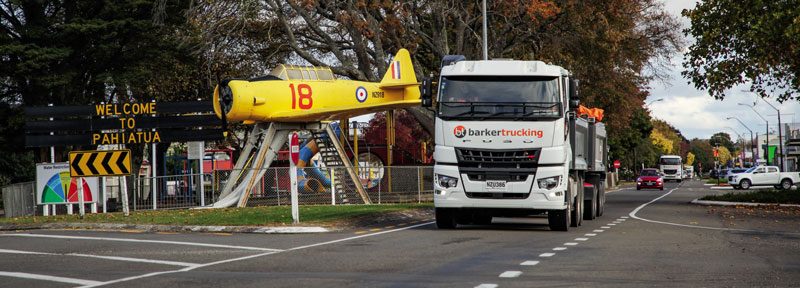
A look at the OM471’s engine performance graph tells the true story. The torque curve is flat from about 910rpm to about 1180rpm (peak is claimed at 1100rpm), from where it dips ever-so mildly to about 1480rpm from when the torque plateau tails off. The power curve reaches its peak at 1600rpm (where the torque is still matching the Isuzu’s peak), but importantly it remains above the 373kW (500hp) mark between 1450rpm and 1830rpm. That’s a 200rpm earlier peak and 400rpm more useable rev range than the 6WG1. By the time the Isuzu’s torque plateau tails off at 1300rpm, it’s only producing about 320kW (430hp). At its power peak, torque has dropped off to just more than 2000Nm.
At a steady 90kph, Scott’s Shogun 510 was humming along at 1530rpm, just past max torque and before max power – a comfortable point in the rev range for maintaining momentum as efficiently as possible. And – given that encouraging engine performance graph – we’re expecting it to make light work of the Masterton- Castlepoint Road which, while not the most challenging, is a twisty and undulating stretch. We’re only going part of the way down, but it’s just enough to get a feel for the 510’s performance when it’s challenged.
Ian is a little ahead in the 460, leading Michael in the new 510, with Scott hanging back a bit. The rate at which he reels them in is impressive, and as we follow the leader, it’s clear Ian is giving the 460 everything it has.
“The way they deliver their power and torque is completely different. The 460 is more rev-happy; the 510s will go down low in the rev range no problem at all,” Scott says.

That lugging ability is the greatest difference between the 11-litre OM470 and the 13-litre OM471. What a difference 2000cc and some tuning can make. The Shiftpilot drops just one gear for us to tackle what’s probably the steepest hill on the road, which we crest at a comfortable 60kph, making use of the torque band between 900rpm and 1200rpm.
Scott continues: “It will pull right down to 800rpm if you really want it to but, generally, if left to do its own thing, it’ll go down to about 1000 before it determines it needs to make a shift. If it doesn’t, it’ll just lock itself in that gear and keep pulling.” Indeed, as we discover, it accelerates easily uphill from low revs and slow speed.
With just 20,500km on the clock, Scott’s 510 is not entirely run in yet, but he says it’s loosened up a lot. “I’ve noticed on a lot of the hills I regularly drive that I’m a gear higher that I was when the truck was new. This gearbox is magic, the shift time is super quick and there’s no drop in power delivery. It will give the truck whatever it needs – two, even three gears.”
(Nicely done, Skip!)
Scott adds that the fuel economy is starting to come right as well, the multi-info display showing 2.2kpl. “Obviously, we do a lot of truck-only work, and we don’t get on a lot of real big hauls – it’ll probably settle about the 2.3 or 2.4 mark,” he reckons. In fact, in the month after we met Scott, the EROAD unit fitted to his truck had shown an impressive average of 2.68km/l.
As it did tackling the inclines, the Shiftpilot knocks just one gear off for the descents as the three-stage Jacob engine brake manages the pace with a strong 375kW (510hp) of hold-back and a gentle rumble emanating from under the cab. Scott and Michael reckon the 510s are excellent on the Jake, “especially compared with the 460, which tends to keep going and get away from you if you aren’t watching,” Scott adds.
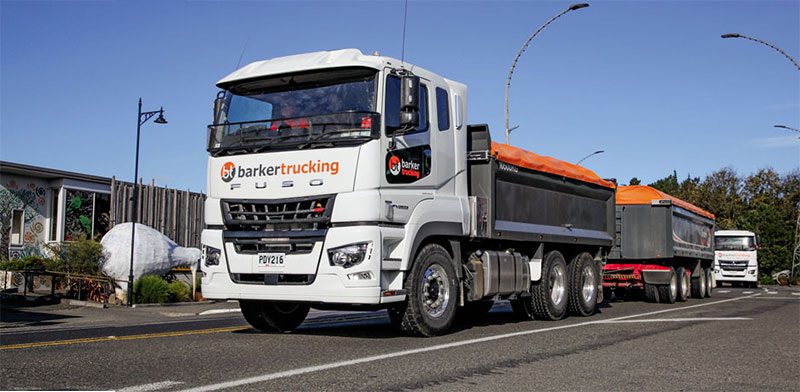
Piece of cake
From the Masterton- Castlepoint Road, we branch off down Bute Road to the farm of fourth-generation owners Nick and Katy Balfour to make our tip. Bute Road is narrow and quickly turns to gravel before giving way to dirt.
The convoy lines up about halfway to the drop-off, alongside a logging gang doing their thing on this section of this expansive farm. We’re met by contractor Damion Stapp and his son Leiken, who have made the trip from Wellington to complete the job. It’s the first time Mike, Scott and Ian have been here, so Scott’s despatched to do a recce with Damion, and they head off to scope out the single-lane dirt access road. It’s steep, loose, twisty and narrow, but the two men are confident it won’t be anything the trucks can’t handle.
Scott leads the way and determines the limited-slip differentials will be up to the task of deploying the power as we get going. Soon, though, the path gets steeper, and a flick of the switch on the dashboard calls the inter-axle lock into play, which Scott leaves engaged for the rest of the climb. He manages the shifting himself, choosing between fifth and seventh as needed. Up and down the cogs, the drivetrain responds to his taps of the wand quickly and smoothly, and at no point on our climb does the Shogun give any hint it’s finding things particularly strenuous. Soon, all three trucks are at the top of the hill, and the boys get to work spreading and depositing the black stuff.
The trucks have room to manoeuvre, but there’s still a bit of positioning to be done. “I’m completely happy on this. For the work we do, it’s just about perfect,” Scott says. “Great steering lock; they turn on a dime. You can just about jackknife yourself on a full turn.” On that point, Mike had jackknife sensors fitted to the 50mm Ringfeders.
The rear air suspension incorporates Fuso’s chassis level-control system (CLCS), which offers the ability to control the height or dump the rear electronically. This is adjustable from the steering wheel or remote control with two memory positions. These rigid tippers sit on the ‘medium’ Shogun wheelbase of 4300mm.
Scott adds: “The way the units are set up as far as bins and drawbar length, they’re ideal for us.”
A familiar office
Not much has changed inside the Shogun with this latest, greatest iteration. We gave it a thorough lookover in the Northern Southland test, but the main talking points are still worth a brief revisit. There’s no denying the Daimler parentage, with a mix of Mercedes-Benz switchgear and instrumentation melding into the typically Japanese design of the dash, wrap and centre console.
The leather-wrapped steering wheel features tilt and telescopic adjustment. Controls at the fingertips include a mix of audio, phone, cruise control and speed limiter, air-suspension height and multi-information display menu access. Climate, infotainment and auxiliary controls all fall easily to hand on the wrap. Brake and tip controls sit right next to the left thigh, easily at hand. Sharing the centre console with the four levers are three lidded cubbies, one of which is lockable. There is a couple of cubbies in the overhead.
“There’s enough place to throw stuff,” comments Scott. “That said, we don’t have much stuff we need storage for.”
Michael’s a believer in utilising technology to make the job easier. The team runs electronic logbooks and uses EROAD Inspect for all prestart checks. The two 510s are fitted with EROAD cameras, and Mike had side-facing cameras installed on the left-hand mirror assembly to increase visibility when manoeuvring “and to try to save mudflaps”.
With no need for a yard or main office, all jobs are managed on mobile through the MyTrucking app. “It’s a great app; it works well for us. If needed, as drivers, we can enter the jobs ourselves, and Mike doesn’t have to do anything,” Scott says.
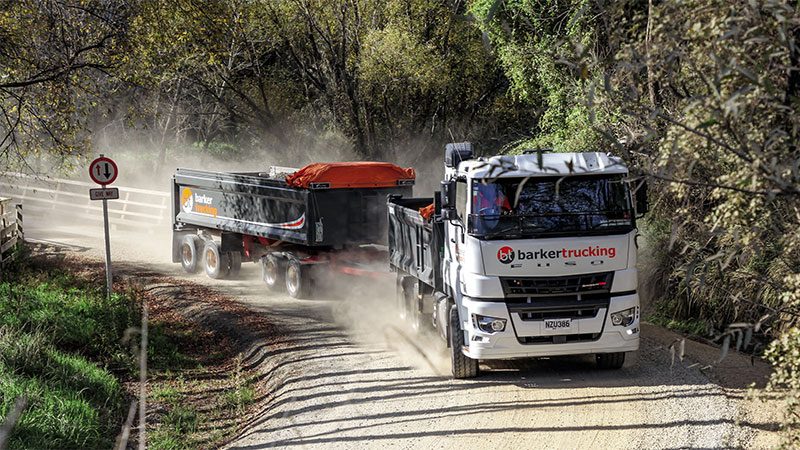
At day’s end
It’s always refreshing to meet an operator like Michael Barker. He’s a man who knows the value of hard work, has been there and done that and should, by all rights, enjoy the trappings of a well-deserved retirement. But, instead, he chooses to get back into it boots and all, not because he needs to, but because he wants to.
He has a simple approach to business, trust in technology, and faith in his team. We left Hawke’s Bay inspired, thinking, ‘Yeah, something like that would be nice one day.’ Of course, there’s also the preference for good gear and loyalty to a brand that has served well.
Fuso Shogun 510 is one of the most anticipated Japanese trucks to land on New Zealand shores recently, and expectations have been high. We expected good things after our jaunt with Clifford, and the teaser with Skip was promising. And now, in the working world with Michael and Scott, the proof in the pudding has been served.
We must commend Fuso, Keith Andrews Trucks and Skip Golden for a job well done. Pigeons scattered.
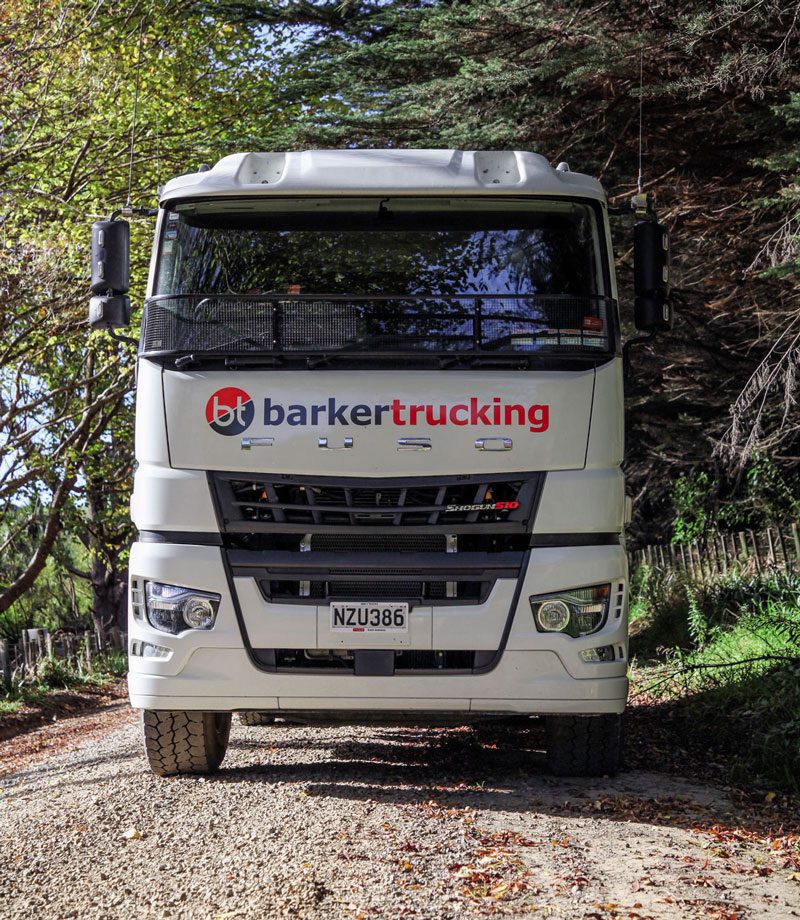
SPECIAL THANKS
Thanks to Michael Barker, Scott Tate and Ian Eriksen for having us along and allowing us to climb all over the trucks. A special thanks to Tina for your generous hospitality.
Thanks to the team from Keith Andrews Trucks, Sophie Song and Chris Holloway for your enthusiasm and information.
Thanks to Nick and Kate Balfour for allowing us access to your farm and experience some of the region’s best scenery. And to Damion Stapp for his insight into the world of contracting.

Read for Part 1
Quick reads from Test
Read more
The right man for the job
0 Comments29 Minutes
Legendary ambition
0 Comments36 Minutes
Hard Fought!
0 Comments40 Minutes
Postal Trifecta
0 Comments29 Minutes















